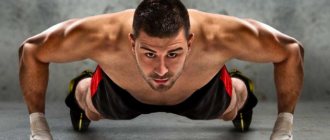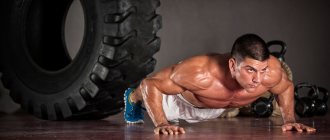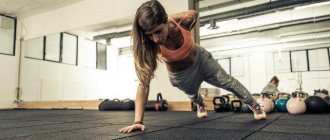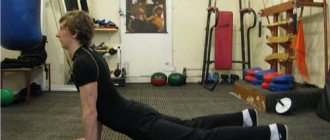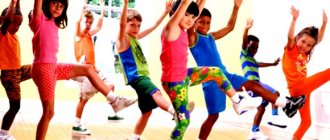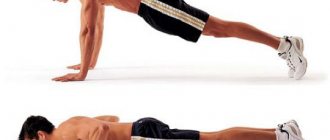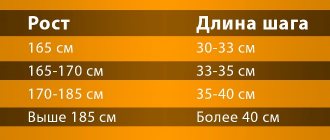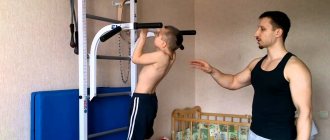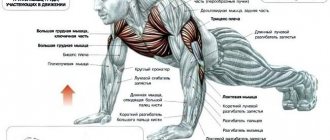It is possible to develop decent muscles even in the absence of exercise equipment and at home. An effective exercise that involves almost all muscle groups is the push-up. However, training preschool children for the purpose of building muscle mass is not an acceptable task. According to experts in the field of health-improving physical culture, significant strength loads, as well as exercises to increase endurance, have a negative effect on the formation of the motor system of children and on the growth of bones in length.
Let us dwell in detail on how parents can teach their child to do push-ups on the floor without harm to the child’s body.
What are push-ups
The term for push-ups in American-English etymology (“puss up”) was first mentioned between 1905 and 1910. After 1945, a more familiar form appeared - “press up”.
Push-ups are a basic exercise that is most often performed in a lying position. It consists of raising and lowering the body using the strength of the arms.
Important! There is a common misconception that doing bench presses is much more effective than regular push-ups. However, this type of bench press eventually injures the rotator cuff. With the same main groups of muscles being loaded, push-ups from the floor, when performed correctly, spare the joints and develop natural strength.
The exercise uses the pectoralis major and minor muscles, the triceps, deltoid and lats muscles, the muscles that support the spine, buttocks, quadriceps, lower legs, feet and toes.
Push-ups for a child
Among various segments of the population, debate continues about the extent to which and at what age a child can be involved in sports and push-ups in particular. There are a number of positive factors, as well as negative consequences (if the technique is incorrect) or contraindications to such physical activity. Let's look at these points separately to form a more holistic picture of the process.
Read about how a child should properly warm up his muscles before doing exercises.
Benefit
Among the positive aspects we highlight the following:
- The most important beneficial aspect can be considered the intensive development of the muscles of the abdomen, back, arms, chest and legs. Having mastered the correct technique, the child will strengthen the joints and tendons, reduce the risk of carpal tunnel syndrome and a number of other joint diseases.
- Exercise increases blood flow, which will cleanse blood vessels more effectively. Push-ups remove sticky adhesions and heal old scar tissue, resulting in less joint damage.
- Systematic classes develop a child’s sense of self-organization and discipline him in relation to his body. In general, playing any sport facilitates the socialization of children and has a positive effect not only on physical but also mental development.
Possible harm and contraindications
You should not do push-ups in the following cases:
- diseased heart. Since any physical activity overloads the cardiovascular system, training becomes simply dangerous for a small person;
- in acute respiratory diseases (especially infectious ones), the heart is also heavily strained. For this reason, it is better to refrain from exercise until recovery.
Learn about effective dumbbell exercises for children.
Features of a child's education
The development of children has its own characteristics, and therefore they need to be accustomed to various physical activities at different years. Let's look at the nuances of learning at different periods of their growing up.
Suitable age for physical activity
Childhood can be divided into several periods:
- age group from 3 to 6 years. Children need to develop flexibility and plasticity, which is lost over time. That is why it is necessary to do daily exercises with them, which is aimed at developing muscle flexibility;
- age group 6–7 years. Training should be aimed at developing cardio loads, working with your own weight, and exercises to work your abdominal muscles. At this age, it is necessary to accustom the child to regular and shuttle running, squats, push-ups and pull-ups, and other exercises that are aimed at developing muscles. Working with additional weight at this age is not recommended, the only exception may be rowing, working with a barbell to work the biceps using minimal weight, working with vertical and horizontal ropes;
- age group up to 10–11. Children are already prepared to perform more anaerobic exercise. These include jump squats, throwing a ball against a wall, box jumps, and barbell work (for example, bench press or military press). Also, do not forget about developing coordination; for this, you can perform exercises such as muscle-ups on rings or a horizontal bar, lunges, and handstand push-ups. However, you should not rush to grab additional weight, because the joint-ligamentous system is not yet prepared for strength training;
- age group from 12 years. Children are already prepared for strength work, and they are classified in the teenage group, where the use of additional weight is allowed. For this age, it is recommended to use light weights in training, working with which will be more effective than using your own weight. And the desired results can be achieved much faster.
Important! Children under 11 years of age should work primarily with their own weight. It is necessary to introduce additional load only after consultation with a doctor who will assess the child’s physiological development, and under the strict supervision of a trainer.
How to assess physical fitness
In the physical development of children, it is not enough to simply be guided by age categories. Children during the period of formation of the body (up to 11–12 years) need clear control of physical development, therefore it is necessary to regularly assess physical fitness. Only with a properly constructed and well-thought-out system of physical development will a child develop as a healthy personality and be able to maximize his or her talents.
There are many different methods for assessing the physical fitness of children. All of them involve the child passing certain tests that will show how prepared he is to perform exercises of a more complex level. A striking example of such tests is passing standards at school, when teachers check the performance of certain exercises and compare them with a table of results that was developed by the Ministry of Education together with the Ministry of Health.
Check out the set of exercises for morning exercises for children.
In the process of assessing a child’s physical fitness, it is necessary to pay attention to the following aspects:
- how well he has mastered certain skills and techniques for performing basic exercises and elements;
- the ability to apply acquired knowledge and skills in various situations;
- on reaction speed, agility, strength, flexibility, coordination and endurance;
- on general activity during exercise.
Based on the assessments received, further adjustments are made to the child’s physical fitness development program. After all, tests clearly demonstrate the imbalance in their physical development.
Method of teaching classic push-ups
As already noted, the most optimal period for teaching a child to do push-ups is between the ages of 6 and 7 years. Of course, these limits are conditional and can be shifted depending on the student’s physical fitness. To master this exercise, we offer the simplest and most effective method, which consists of 6 steps:
- We take the starting position lying down, arms bent at the elbows, at shoulder level. The main thing in this position is that the forearm is perpendicular to the floor. The legs are connected together.
- We straighten our arms, but at the same time the body should remain straight, and our knees should not be lifted off the floor.
- We straighten our legs and at the same time make sure that the body and legs form a straight line.
- Fix your body in this position for a couple of seconds.
- At the count of 1–2–3–4–5, slowly lower your straight body to the floor.
- Touching the floor with the chest, we return the body to the starting point.
We repeat several times.
Some children do push-ups incorrectly, and there are several reasons for this:
- the simplest and at the same time banal: no one has ever shown how to perform this exercise correctly. In this case, to perform it correctly, it is necessary to demonstrate this exercise by a person who has authority for the child. This could be a father, a coach or a mentor;
- fatigue, which does not allow you to maintain the correct body position. If you notice that your child is doing push-ups incorrectly, you need to give him a rest or stop doing this exercise altogether.
Important! When performing this exercise, you must clearly monitor the correct position of the body, i.e. the body from head to heels should form a straight line, and the arms at the starting point form an angle of 90° with the floor.
Improperly performing push-ups negates all the benefits of them, and sometimes even harms tendons and joints, so the child needs to be supervised from the very beginning so that he performs the approaches correctly. The goal of any parent who wants to teach a child push-ups is to introduce him to physical activity and a healthy lifestyle.
Push-up patterns
To strengthen your arms and chest, you can do several push-ups.
Scheme 1
Every morning you perform 10-30 push-ups in the same position. Namely, as recommended by the GTO standards - that is, the body is straight, like a string, and the elbows are not spaced further than 45 degrees relative to the body.
For maximum effect, hold in the lower position for half a second.
This circuit will help you target your triceps and chest muscles evenly.
Scheme 2
Every morning you do 20-40 push-ups in 4 variations:
- Elbows pressed to the body - 5-10 times. Here the main load goes to the triceps.
- Elbows to the sides, palms inward - the same amount. Breasts work.
- 5-10 times in the position indicated in diagram 1. Uniform load.
- 5-10 times on fists. Fists are needed to increase the range of motion. This will engage the pectoral muscles more.
Scheme number 2 will strengthen your triceps and chest from all sides. This is the most preferable option if you want to give a complex load to the body while charging. If you just need to do push-ups, Scheme 1 would be preferable.
Now you can see for yourself that thanks to push-ups you will be healthy and ready for work and defense at any time.
They will not provide a serious increase in mass or enormous strength, but are perfect for people who do not have time for the gym to keep their body in shape.
https://youtu.be/WQpIGna2W10
Other push-up methods for children
If your child’s physical fitness does not allow him to do push-ups, then you can use other methods that are lighter versions of push-ups. We offer several variations of this exercise that will help improve your child’s physical fitness.
From the wall
This exercise is ideal for the very beginning level. It allows you to strengthen the muscles of the pectoral and shoulder girdle, improves blood circulation in these areas. Wall push-ups also help you lose weight in your arms.
Technique:
- Starting position - you need to rest your palms against the wall, and they need to be spaced slightly wider than your shoulders.
- Take a few steps to get as far away from the wall as possible. In this case, the arms should be straightened and parallel to the floor.
- While inhaling, bend your arms at the elbow joint until your forehead or nose touches the wall. When bending your arms, you must carefully monitor their position; they must remain parallel to the floor, while your body forms a straight line.
- As we exhale, we slowly return to the starting point.
For beginners, you need to do 10 repetitions; when the muscles become stronger, you can move to the intermediate level. The intermediate level involves 20 repetitions in 2 sets. For advanced - 50 repetitions of 3 sets.
Did you know? Wall push-ups work parts of the body such as the wrist, elbows, and shoulders, that is, those areas that are most often subject to injury. In addition, this exercise warms up the muscles well and prepares them for other more complex exercises.
From a bench (chair, sofa)
This exercise is aimed at strengthening the deltoid muscles and is a slightly more complicated version of the previous one. To perform this you will need a low chair or you can choose an armchair or sofa. In height they should be at mid-thigh level.
Technique:
- Starting position - stand at a distance of 60 to 90 cm from the bench, place your feet wider. Place your hands on the bench, with the distance between them equal to shoulder width or slightly more. The whole body should be straight.
- Inhaling, we lower ourselves down, bending our arms. The main thing when doing this is not to lower or raise your pelvis.
- As you exhale, we return to the starting position.
This type of training requires 12–15 repetitions; to make it more difficult, you can do several approaches.
Find out how to teach your child to do pull-ups.
Off the floor, on my knees
This push-up helps protect your lower back from overexertion. This exercise is recommended for beginners and for children who have problems with the lumbar region.
Technique:
- Get on all fours, place your arms so that your torso, pelvis and legs from your knees form a straight line.
- From the starting position, while inhaling, bend your arms at the elbow joint.
- As you exhale, we return to the starting point.
When performing this exercise, it is necessary to monitor the position of the pelvis, and at the same time, the shin should not be raised too high, since in this position the load on the lumbar region increases, and the back bends in this place.
How many times to do push-ups in the morning
It is advisable to limit yourself a little in push-ups so as not to overwork your muscles. If you decide to exercise daily, you don’t need to overwork yourself.
To determine the number, do as many push-ups as you can in the morning. Take 60-80% of this number, round up and do push-ups this number of times as exercise. This way you will know how many push-ups you need to do per day.
You can make it even simpler - use round numbers. For example, do 10 or 20 push-ups in the morning. After charging, you should have some reserve of energy left, because there is still a whole day ahead.
When to expect the first results
If you train daily, the results will not take long to arrive. After just 3 weeks of regular training, you will notice how your child has become stronger and can perform more repetitions and even several approaches; over time, he will independently perform more complex variations of push-ups.
Did you know? Andrey Kostash, at the age of seven, completed 4,000 push-ups in 2.5 hours, making him the youngest and hardest record holder in Ukraine.
Don't force your kids to do push-ups. It is best to start with wall push-ups and gradually increase the load, especially since the muscles must get used to the load.
It is necessary to engage in physical training from an early age. The age of 6-7 years is the best time to teach children push-ups. And the best example for a child will be his parents, who will show him how to do it correctly.
Exercises Push-ups Children Sports and fitness Exercises for children
How to learn to do a lot of push-ups
No matter how strange it may sound, in order to learn how to do a lot of push-ups at one time, you need to do a lot of push-ups. This means that during the day you need to do 1-2 endurance workouts.
How many push-ups should you do per day? As much as possible. Find out your current maximum number of repetitions and aim to increase this number by one repetition every day.
There is another way. Divide the workout into 5-6 approaches. In the first set, perform 80% of your one-time maximum repetitions, and in each subsequent approach add one repetition. Try to progress the load in each workout - this is the key to success.
Rep Increase Program
Let's say your maximum is 50 push-ups at a time. This means that the first set starts with 40 repetitions.
- first approach – 40 repetitions;
- second – 41;
- third – 42;
- fourth – 43;
- fifth – 44;
- sixth – 45.
Rest between sets for 30-60 seconds. If you can’t complete the program right away, don’t give up. Remember, you have to do as many push-ups as you can, and everything will work out.
